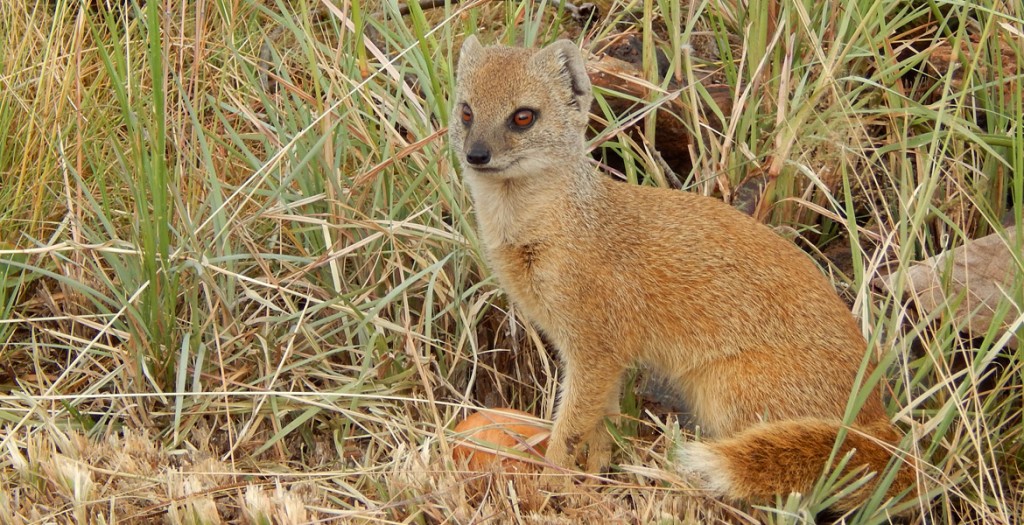
We have some mammals that occur in the wild on our Estate. Urban sprawl and things like fencing off of their boundaries mostly threaten their habitat and hunting grounds. Let us hope the few that still do occur here, will be respected, protected and left in peace by all landowners. The following is just a very short description of mammals found in our area. More will be added to the list as and when evidence is found of more species.
Click on any of the small pictures to open the full-size photo
All photos by Elmarie and Garfield Krige
Yellow Mongoose (Cynictis penicillata)
Rooi meerkat/witkwasmuishond (A)
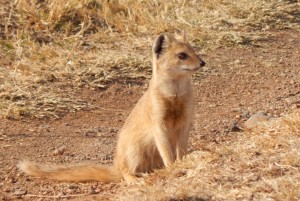
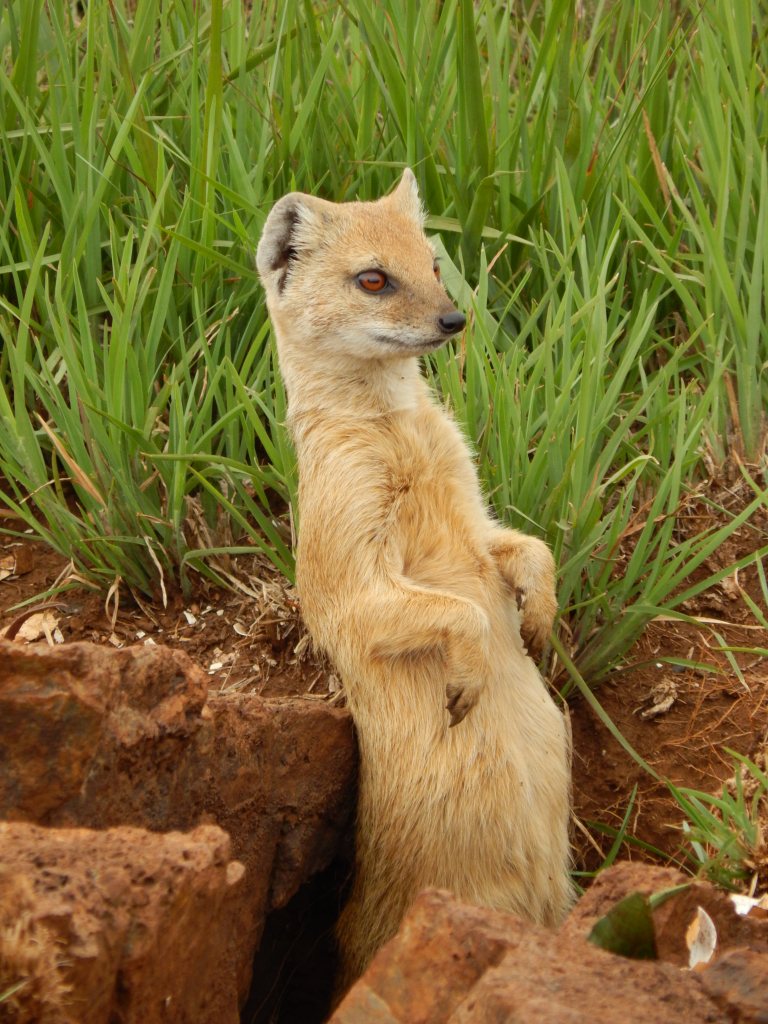
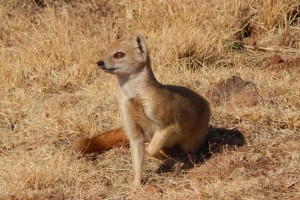
It is the only member of its genus, but as many as 12 subspecies have been recognized. They have a hierarchical social structure and live in colonies of about 20. The male will mark boundaries with anal and facial secretions as well as urine, and he will rub his back against raised objects, leaving behind fur as a visual marker of his territory.
The yellow mongoose often shares their burrows with the Cape Ground Squirrels or other meerkat, adding new tunnels and burrows as the need arises. A burrow has more than one entrance. Mainly active during the day and weather (such as rain, cold, prevailing winds etc) will also influence their outside activities. On cold days they can often be seen warming themselves outside the burrow in the sun before setting off to hunt for food. They are mainly carnivorous, feeding on insects and invertebrate, small mammals, lizards, snakes and eggs of all kinds. They do play an important role in controlling certain insects, snakes and rodents.
In the southern, cooler, parts of their habitat, their hair is longer, more reddish to yellow and their tails are longer, bushier and with a distinctive white tip. In the northern, warmer parts (Namibia etc.) they are of a more grayish colour. The young is usually much lighter in colour than the adults. It is believed they are not capable of sexually reproducing until one year of age.
Some interesting facts: The alpha male will mark members of his group every day with anal secretions!
Another interesting fact of the yellow mongoose is that they have five digits on its forefeet and four on the hind feet. The first digit of the forefoot is raised above the rest and does not make an impression in its spoor.
The palm of the forefeet is basically naked, but hairy in the hind feet. The claws in the forefeet are also longer than on the hind feet.
I have described these little mammals in detail in my Celtis africana information letter (see Downloads – December 2013)
Average weight: 500 – 830 g
Average length: About 60 cm (including the tail of about 24 cm)
Small-spotted Genet (Genetta genetta)
Kleinkolmuskeljaatkat (A)
There was a report from one of the landowners of seeing something very clearly resembling a small-spotted genet late one night near the entrance, and I am hoping this could be confirmed by somebody with a camera at hand! We have seen one run over by a car close to the bridge (near our Estate’s entrance) on the N14 once. Unfortunately this does happen as they get confused by blinding headlights and easily get run over. But they definitely occur in our area.
These mammals feed mainly on invertebrates and small rodents, but its diet also include reptiles, nestling birds, amphibians and wild fruit. They are nocturnal and secretive and live mainly arboreal. Their excellent vision allows them to jump from branch to branch, or on to their prey. They have a long slender body and short legs; the body is off-white to grey-white with small dark spots. It has a long, bushy tail, ringed in black with a white tip. Its ears are fairly elongated, round and thin – looking almost transparent. Their eyes are large with distinct white markings underneath. Along the ridge of its back is a row of black hair that will be raised when threatened.
Interesting fact: They have excellent, and, what is described as binocular vision, which allows them to judge distances very accurately.
Average length: 85- 100cm (including its long tail of around 45cm)
Average weight: 1.6 – 2.9kg
Porcupine(Hystrix africaeaustralis)
Ystervark (A)
These rodents are mainly nocturnal, but sometimes are found foraging for food during the day. Contrary to their American cousin that climbs trees, the African porcupine is not a climber and forages on the ground. They are avid diggers and feed primarily on roots and tubers. Tree bark is also favoured.
The black and white quills may be raised and rattled when threatened or angered. That they can “throw” their quills at an enemy has long been refuted. The quills can be released when touched or when it shakes its body. New quills grow to replace the lost ones. Baby porcupines are born with soft quills which harden a within a few days after birth.
Interesting fact: Their quills have recently inspired a new type of hypodermic needle. Because of the back-facing barbs on the quills, it makes them good at two things, penetrating the skin and remaining in place, which was incorporated in the design of this hypodermic needle!
Average length: 75 – 100 cm
Average weight: 10 – 25 kg
Cape Hare (Lepus capensis)
Vlakhaas (A)
This long-eared and long-legged; mainly nocturnal mammal feeds mainly on grasses and herbs. When threatened it will run off in a zigzag manner. The belly is off-white and the back varies in colour from soft brown, to fawn-grey to reddish brown. It usually has a white ring around the eye and a very indistinct buffy band on its side. Unusually amongst mammals is that the female of the Cape hare is bigger than the male – this phenomenon is called sexual dimorphism. Like other hares they are very fast – the only animal capable of outrunning them is the cheetah! All other predators are ambush and/or opportunistic hunters.
Interesting fact: A characteristic of hares which differentiate them from rabbits is that the young are born precocial: in other words they are born with their eyes open and are able to move about shortly after birth!
Average length: 48 cm
Average weight: 2 kg
Scrub Hare (Lepus saxatilis)
Kolhaas (A)
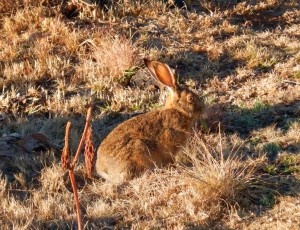
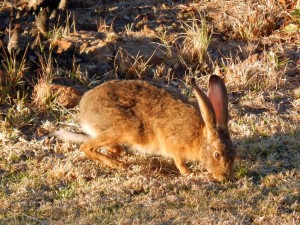
Very difficult to distinct from the Cape hare, except for the absence of the buffy band on its side and that it is slightly larger than the Cape hare. Feeding habits are the same and typically the female is also larger than the male.
Average length: 54cm
Average weight: 2-3 kg
Hedgehog (Atelerix frontalis)
Krimpvarkie (A)
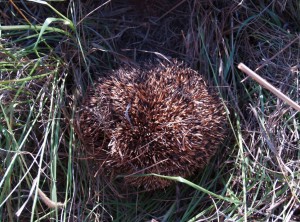
This small nocturnal mammal is becoming quite rare. It has short brownish-black and white spines and a sharp little snout. Urban sprawl and the often-thoughtless use of rodent poison by man, have played a big role in them becoming scarcer. It was always considered to be insectivorous but has evolved to become omnivorous due to habitat loss (urban sprawl) and the trash from humans becoming so readily available. It’s a voracious predator of crickets, termites, and worms and is very useful in gardens.
When threatened it will curl up in a little ball by contracting a circular muscle, acting like a purse string!
Interesting fact: Babies are born blind, deaf and without spines. Spines appear within 2-4 hours after birth. The eyes start opening around 20 days after birth.
Average length: 20 cm
Average weight: 280- 350 g (male) and 300-500 g (females). Females are larger than males.
Steenbok (Raphicerus campestris)
Steenbok (A)
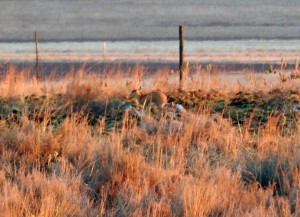
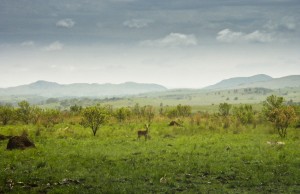
Ever since we move here first, we have noticed a slow decline in these lovely antelope’s numbers, which might be contributed to the fact that we have often found traps when walking in the veld. That really makes one angry!
The steenbok’s coat is anything from fawn to rufous but typically more orange in colour. Its underside, chin and throat are white and it has a white ring around the eyes. They have a slender black triangle, starting at the nose, tapering upwards. Only the male has a set of smooth, sharp horns. The tail is very short and almost invisible and they have a very large pair of ears. They have excellent hearing.
Their habitat is open grassland and is said to favour unstable or transitional habitat with no tendency to migrate to moister areas during the dry season (see: interesting fact below). In cooler weather they are active throughout the day but when the climate is very hot they tend to take a rest in the shade.
Steenbok appear to live in monogamous pairs, sharing a specific territory. However, they are usually found apart and only come together for mating. Whilst living independently, they stay in contact through scent markings, so they know where their mate is most of the time! Their scent marking is primarily through dung middens. Breeding is thought to occur all-year round. The fawn is concealed the first three to four months. The mother will only make contact early in the morning and evening to groom and feed it. In an effort to conceal the lamb’s hiding place, the mother will drink its urine and eats its faeces when visiting it, keeping the hiding place for the most odour-free and safe from predators. They are the only bovid who scrape the ground before and after urination and defecation.
They are exclusively browsers, showing a distinct preference for forbs (herbaceous flowering plants). They are low-level browsers of vegetation such as soft, new leaves from lower branches of trees and shrubs, flowers, fruit and rarely grass. In drier periods they consume tubers and roots, which they scrape up with very sharp hoofs.
Interesting fact: They hardly ever need drinking water, gaining almost all of their moisture needed from their food!
Average length: 70 – 95 cm
Average height: 45-60 cm (shoulder height)
Average Mass: 7 -15 kg
Common mole rat (Cryptomys hottentotus)
Gewone mol/Vaalmol (A)
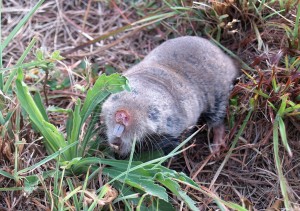
This is a small, short-legged rodent with very small eyes, hidden ears and protruding teeth. These chisel-like incisors are used for digging. They are characterized in having one production pair consisting of the largest male and female in the group. The rest of the group is workers, the young moles doing most of the work and the older moles being more casual workers.
They are herbivores living mainly off plants with underground storage organs, grass rhizomes and large quantities of fibre found in the roots of many plants. Although not liked by man because of their destructive nature in gardens, but their digging also has a positive effect in that it improves soil drainage and turnover. They have the ability to generate their own heat and in arid areas, they have lower individual body masses to help them conserve energy.
Interesting facts: The mole rat has loose skin so it can fit in small spaces; it can practically somersault within its own skin! It has hair behind its teeth to prevent any dirt and soil from getting into its mouth!
Another interesting fact, and, I think a quite sweet kind of “foreplay”, is that, during courtship, the female will raise her tail to allow the male to smell her genital region. The male then gently chews on her hind region, mounts and mates!
Average length: 10 – 16 cm
Average weight: 100 – 150 grams
Black-backed Jackal (Canis mesomelas)
Rooijakkals (A)
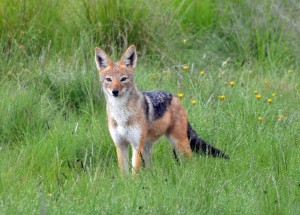
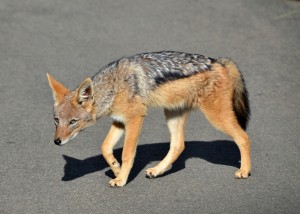
This dog-like mammal is omnivorous and the English name describes its black “saddle” on its back, whilst the Afrikaans name refers to the rich reddish flanks and limbs. It has a bushy tail and high, upstanding pointed ears. The chest and underparts are white, sometimes tinged a rusty colour. The black-backed jackal has a distinct wailing call, usually answered immediately by family members and a short while later by nearby individuals or groups.
Their calls are most frequently heard during late afternoons or evenings and there is also a seasonal peak in calling during the months of June and July, which corresponds with the main mating season.
They are monogamous and are thought to mate for life. Its prey includes insect, lizards, rodents, snakes and wild fruit and berries. In many parts where larger predators have been eliminated, they play an important role in maintaining the health of the ecosystem. It will select sick or weak antelope as prey and in doing so, remove animals that would otherwise release enormous numbers of parasites into the environment. It scavenges where carcasses are available.
Interesting fact: The fossil record indicates this species is the oldest living member of the genus Canis.
Average height: 30 – 48 cm (shoulder height)
Average length: 60 – 90 cm (tail 26 – 40 cm in length)
Average weight: 6 – 10 kg (the males are slightly heavier than the females)
Vervet Monkey (Chlorocebus pygerythrus)
Blou aap (A)
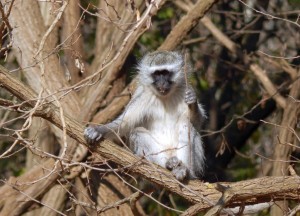
The vervets seem to be seasonal visitors to our Estate. Wintertime they are rarely seen, possibly migrating to where food is more available. The vervet monkey is mostly vegetarian and has black faces with a white fringe of hair, and the body hair is grey in colour, ranging in length from about 19 in (50 cm) for males to about 16 in (40 cm) for females. They live in social groups ranging from 10 to 70 individuals, with males changing groups at the time of sexual maturity. Females remain in their groups throughout their lives.
They live mostly on wild fruits, flowers, leaves, seeds, and seedpods as well as grasshoppers and termites. They have been known to raid the nests of cattle egrets and weaverbirds, eating both the eggs as well as the young. In agricultural areas they have become problems raiding grain crops as well as various vegetables crops.
Human development is the main factor in their diminishing numbers although they are regarded on the IUCN Red list as “of least concern”. However, as human development has encroached on wild territories, they are killed by electricity pylons, vehicles, dogs, pellet guns, poison, and bullets, and is trapped for traditional medicine, bush meat, and for biomedical research. The vervet monkey has quite a complex and fragile social system, and persecution of the species is thought to have affected troop structures and diminishing numbers.
Some interesting facts: Research has shown that they suffer from human-like characteristics such as hypertension and anxiety.
Mothers can recognize their offspring by a scream alone. Although a juvenile’s scream will cause a reaction from all mothers, the juvenile’s own mother will look quicker over to her offspring and the duration of her look will be longer. Mothers have been observed to help their own offspring in conflict situations, yet rarely come to the aid of other juveniles.
Mothers can evidently determine to which mother an offspring belongs; individuals have been observed to look towards the mother of an offspring, screaming at a certain moment in time.
Average length: 49 cm (from the top of the head to the base of the tail); females are slightly smaller with an average length of 42.6 cm
Average weight: Males average between 3.9 and 8 kg, whilst the females average between 3.4 and 5.3 kg.
Elephant shrew (Macroscelididae)
Klaasneus (A)
(The biologist Jonathan Kingdon (born in Tanzania and is a research associate at the University of Oxford, UK) proposed they instead be called sengis – a term derived from the local languages in Africa)
These little mammals have a rodent-like appearance but are not rodents at all.
The name “elephant shrew” is also a total misnomer, as they are neither elephant nor shrew, but are more closely related to elephants than to shrews. Their elongated noses are used much in the same way as an elephant uses its trunk.
Elephant shrews are insectivorous and live on invertebrates such as spiders, insects, centipedes, millipedes and earthworms and use it’s nose to sniff them out and uses it’s tongue to flick food into their mouths – much like an anteater! Some elephant shrews also feed on small amounts of plant matter when available, especially new leaves, seeds, and small fruits. They are very well camouflaged and fast and able to run away from danger very quickly. They make pathways in the undergrowth, patrolling it throughout the day for food; it also provides a clear getaway for them when in danger.
They are not always social and mainly get together for mating purposes, which can last a couple of days after which they go their solitary ways. The young are well developed and can move around independently within hours after birth.
Interesting fact: The female elephant shrew undergoes a menstrual cycle, similar to that of human females!
Average length: 26 cm (including the tail of 13cm)
Average weight: 60 g
These little mammals are described in detail in my Celtis africana information letter (see Downloads – May 2014).
Reddish-grey Musk Shrew (Crocidura cyanea)
Skeerbekmuis (A)
Very small insectivorous mammal with a long snout, small rounded ears, very small eyes and russet-grey to reddish-brown coat. Although it may look a lot like mice they are not rodents at all. Occurs mostly singly, sometimes in groups, and have alternating active and resting periods during a 24-hour period. These voracious feeders are able to eat their own bodyweight in food per night. Feed mostly on insects and other small invertebrates, sometimes plants. A litter of 2-6 naked and helpless young are born in the warm, wet summer months.
Average total length: 10 cm (including tail of about 4 cm)
Average weight: 8 g
Highveld Gerbil (Gerbilliscus brantsii/Tatera brantsii)
Hoëveldse nagmuis (A)
This mammal is strictly nocturnal and rarely seen, but its presence may be detected from a number of small mounds and little holes in sandy soil. Feeds mainly on grass seeds, plant food and berries as well as insects. Their upper parts are most commonly reddish-brown, bright and silky and their underparts white to grayish-white. Litter size varies from 1- 5, usually 3.
Interesting fact: It does not hoard food – unusual for a gerbil.
Average length: 28 cm (including tail of about 14 cm)
Average weight: 80 g
House Mouse (Mus musculus)
Gewone Huismuis (A)
This very common mammal is nocturnal and omnivorous. Small, long-tailed rodent with dull grey coat and rounded ears Very adaptable to any circumstance and are seen as destructive as it breeds prolifically.
Average length: 16 cm (including tail of 9cm)
Average weight: 18 g
House Rat (Rattus rattus)
Gewone rot (A)
This large, long-tailed rodent has a grey-black coat and round ears. It is omnivorous and destructive, and like the house mouse arrived in South African ports from Europe from where it spread inland.
Average length: 37 cm (including 20 cm tail)
Average weight: 150 g
Striped Mouse (Rhabdomys)
Streepmuis (A)
This little mammal is plentiful in our area and is slightly larger than the common house mouse. It displays four black longitudinal stripes on a paler background. Unlike other mice, they are mostly active during the day and concentrated activities are early morning and late afternoon. It rarely, if ever will enter households, as open grasslands are its preferred habitat.
They are omnivorous and are able to survive without water as long as their diet contains a minimum of 15% water. They will feed on insects opportunistically, but their main food is seeds and vegetable matter as well as certain forbs. They will also eat the underground storage organs of certain small species of geophytes such as edible Moraeas, which they can locate by smell and then dig up.
This little rodent is an important prey for many species of snake, as well as for small to medium-sized carnivores such as the caracal, serval, wildcat and black-footed cat, jackal, and several species of mongoose. They also are major food items for several species of birds of prey. Even owls take advantage when they catch the mice in their late afternoon/early evening activities.
Interesting fact: Striped mice from the south-western regions of southern Africa are slightly larger than animals from the more northern regions.
Average length: 105 mm (head and body, and same length for tail)
Average weight: 45 – 50 g
Bats (Mammals of the order Chiroptera)
Vlermuise (A)
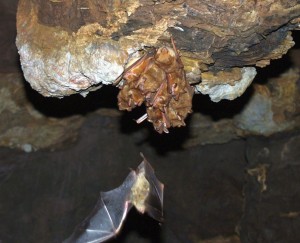
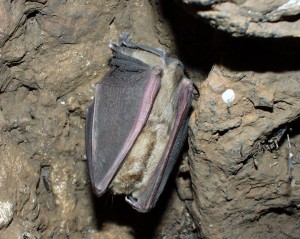
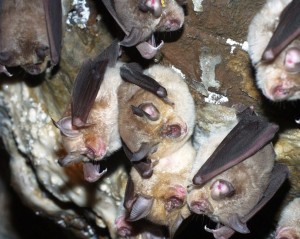
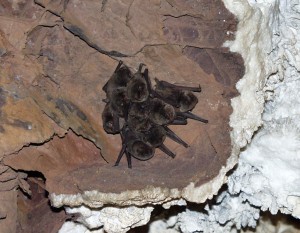
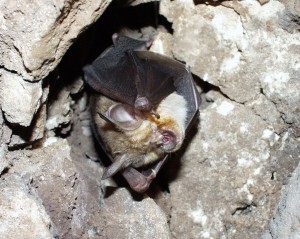
All photos taken within a few kilometres of our Estate.
Bats occur in our area although I have not been able to identify which species. Species that may occur in our area are the Cape Serotine bat, Common Slit-faced Bat, Geoffroy’s Horseshoe Bat and the Yellow House Bat.
Bats are the second largest order of mammals after rodents. Their forelimbs form webbed wings, making them the only mammals that are naturally capable of true and sustained flight. The above-mentioned bats are all insectivorous and are seen flying at dusk, except for the Slit-faced bat which rarely emerges until well after dark. These mammals are ecologically very important as they consume large amounts of insects and economically they reduce the need for pesticides.
Average length:
- Cape Serotine Bat: 8cm
- Common Slit-faced Bat: 10 cm
- Geoffroy’s Horseshoe Bat: 10cm
- Yellow House Bat: 10 cm
Average wingspan:
- Cape Serotine Bat: 23 cm
- Common Slit-faced Bat: 24 cm
- Geoffroy’s Horseshoe Bat: 32 cm
- Yellow House Bat: 30 cm
Average weight:
- Cape Serotine Bat: 6 g
- Common Slit-faced Bat: 11 g
- Geoffroy’s Horseshoe Bat: 17 g
- Yellow House Bat: 27 g
References and acknowledgements: The field guide to the Mammals of Southern Africa – Chris Stuart, Tilde Stuart; Wild about Johannesburg – Duncan Butchart; Wikepedia website; Krugerpark website; IUCN Red list.